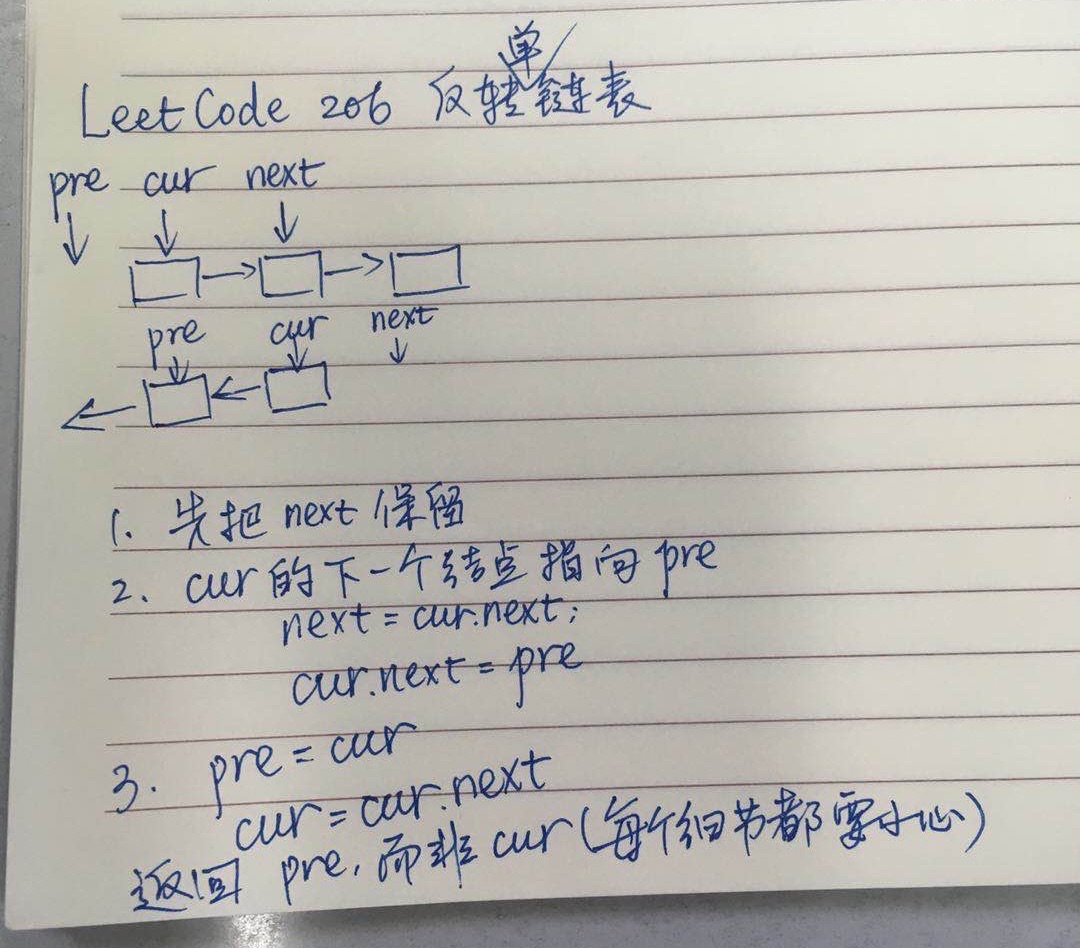206. reverse-linked-list
题目描述和难度
- 题目描述:反转一个单链表。
- 题目难度:简单。
- 英文网址:206. Reverse Linked List 。
- 中文网址:206. 反转链表 。
思路分析
求解关键:画图,这样思路和代码都会很清晰。

- 在画图的过程中,我们就可以分析出完成翻转链表这件事情,一共要用 3 个指针
pre、cur、next: - 当前遍历的
cur指针不必多说,是一定有的; - 当前结点的 next 指针要指到它前一个结点,所以
pre也必须有; -
迭代要继续下去,
cur结点的下一个结点也得使用一个指针next保存一下,其中next可以在cur确定以后初始化;。 -
画图分析
next指针的指向,我们注意到我们分析出来的指针指向的先后顺序,通常跟数组的元素交换操作一样,程序写出来是“头尾相连”的,是不是很酷! - 最后一定不要忘记,返回的是
pre节点。
如果你觉得穿针引线麻烦,那就交给递归来做这件事情吧。
参考解答
参考解答1:穿针引线
Java 写法:
// https://leetcode-cn.com/problems/reverse-linked-list/description/
class ListNode {
int val;
ListNode next;
ListNode(int x) {
val = x;
}
public ListNode(int[] nums) {
if (nums == null || nums.length == 0) {
throw new IllegalArgumentException("arr can not be empty");
}
this.val = nums[0];
ListNode curr = this;
for (int i = 1; i < nums.length; i++) {
curr.next = new ListNode(nums[i]);
curr = curr.next;
}
}
@Override
public String toString() {
StringBuilder s = new StringBuilder();
ListNode cur = this;
while (cur != null) {
s.append(cur.val + " -> ");
cur = cur.next;
}
s.append("NULL");
return s.toString();
}
}
// 很常规的一道问题,关键在于画图分析
// 每一次遍历都要保证设立的 3 个指针的相对关系
// 注意,最后应该把 pre 指针返回
// 这个解法的时间复杂度是 O(n),因为它仅仅遍历了一次链表,空间复杂度是 O(1),因为这里仅仅使用了有限个的“指针”,帮助我们完成了链表的反转操作。
public class Solution {
public ListNode reverseList(ListNode head) {
// 初始化上一个指针
ListNode pre = null;
// 初始化当前指针
ListNode cur = head;
ListNode next;
while (cur != null) {
// 第 1 步:初始化 next 指针
next = cur.next;
// 第 2 步:实现当前节点的 next 指针的反转
cur.next = pre;
// 第 3 步:重新定义下一轮迭代的循环变量
pre = cur;
cur = next;
}
// 遍历完成以后,原来的最后一个节点就成为了 pre
// 这个 pre 就是反转以后的新的链表的头指针
return pre;
}
public static void main(String[] args) {
int[] nums = {1, 2, 3, 4, 5};
ListNode head = new ListNode(nums);
System.out.println(head);
Solution solution = new Solution();
ListNode reverseList = solution.reverseList(head);
System.out.println("反转之后");
System.out.println(reverseList);
}
}
Python 写法:
# Definition for singly-linked list.
# class ListNode:
# def __init__(self, x):
# self.val = x
# self.next = None
class Solution:
def reverseList(self, head):
"""
:type head: ListNode
:rtype: ListNode
"""
pre = None
cur = head
while cur is not None:
next_temp = cur.next
cur.next = pre
pre = cur
cur = next_temp
return pre
参考解答2:递归写法
Java 写法:
/**
* 不想穿针引线,那就递归来做这件事情吧
*
* @author liwei
*/
public class Solution2 {
/**
* 反转一个单链表
* 步骤:先写递归终止条件,然后假设规模小一个级别的问题解决了,思考如何与原规模的问题建立联系
*
* @param head 单链表的头结点
* @return 反转以后单链表的头结点
*/
public ListNode reverseList(ListNode head) {
if (head == null || head.next == null) {
return head;
}
// 其实这一步做的也是穿针引线的工作了
ListNode nextNode = head.next;
ListNode reverseList = reverseList(nextNode);
nextNode.next = head;
head.next = null;
return reverseList;
}
public static void main(String[] args) {
int[] nums = {1, 2, 3, 4, 5};
ListNode head = new ListNode(nums);
System.out.println(head);
Solution2 solution2 = new Solution2();
ListNode reverseList = solution2.reverseList(head);
System.out.println("反转之后");
System.out.println(reverseList);
}
}
Python 写法:
# Definition for singly-linked list.
# class ListNode:
# def __init__(self, x):
# self.val = x
# self.next = None
class Solution:
def reverseList(self, head):
"""
:type head: ListNode
:rtype: ListNode
"""
if head is None or head.next is None:
return head
# head 的下一个结点先存起来
temp_node = head.next
new_head = self.reverseList(temp_node)
temp_node.next = head
head.next = None
return new_head